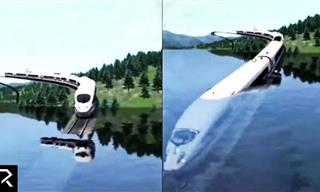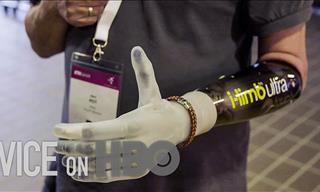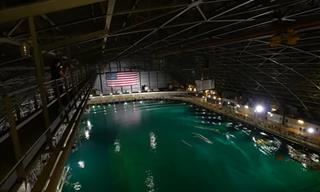
Most of us associate kites with our childhood. Perhaps, it is time to rethink that concept today. A California-based company named Makani in collaboration with energy giant Shell has created a self-flying ‘energy kite’ that aims to tap into the growing wind power around the world.
This is exciting news because the technology that has been developed can harness the strongest winds in the middle of the ocean. These are spots that are too far for the offshore turbines to reach. The company’s autonomous and light-weight kite looks like an airplane strapped to a base and installed on a floating platform in the water. Currently, tests are underway off the coast of Norway to determine the feasibility of the device.
You would be surprised to know that merely 6 percent of the world’s energy comes from wind power at present. Makani’s goal is to utilize the energy kite to produce utility-scale power which will in turn help in electrifying communities around the world.
An energy kite uses a wing that is bound to a ground station to effectively harness energy from the wind. As the kite reaches a height of about 300 meters (984 feet), it starts gliding in a vertical loop. When the kite flies independently in a loop, the rotors on its wing spin as the wind moves through them and drive a permanent magnet motor-generator. This allows the production of electricity that moves down the conductive tether and is transferred onto the grid.
Apart from being super lightweight, these kites are made of carbon fiber and have an 85-foot (26 meters) wingspan. The device is launched from a base station and is bound by a 1,400-foot (426.7 meters) tether. It then flies autonomously in circles with the assistance of computers. The company has stated that each of these kites has the capacity to generate around 600 kilowatts of electrical power. This would be sufficient to power almost 300 homes.
Furthermore, these energy kites are almost 90 percent lighter than turbines of an identical power rating. Their benefits are hence numerous.
Millions of people who live near the ocean don’t have a good resource for renewable power but do have offshore wind resources. These lightweight energy kites can make it possible for tapping that resource in the most economical way while also bringing renewable power to countless people's homes.
“Currently there is no available technology that can economically produce energy from the wind in these places,” technical program manager Doug McLeod was quoted as saying at the Airborne Wind Energy Conference 2019. “As a floating airborne wind energy technology, Makani believes that we can unlock this stranded resource.”

Image credit: Makani
Initially, two tests were conducted at the North Sea in August 2019. The first flight was a quick one and the second was a longer-duration test that followed commands from the flight controller. Both the tests relayed plenty of useful information to the engineers that they will use to conduct more simulated test flights and further enhance the system.
Meanwhile, the results of the ongoing tests in Norway will soon determine if the energy kites can survive and function in a range of environmental conditions and will also help perfect their landings at sea. If these tests prove to be successful, it could be a breakthrough for floating offshore wind and become a big step towards increased access to energy resources that have been trapped for long above waters that are too deep for fixed wind turbines. Most importantly, it will help provide electricity to so many people who live along the world’s coastlines.
Visit the Makani website for more details.
 10:59
10:59
Would You Like to Take a Ride in Dubai's Underwater Train?
Take a look at some of the most ambitious and incredible engineering projects currently underway in Dubai.
 11:53
11:53
Find Out How Bionic Limbs Are Transforming Countless Lives
Discover how a bionic revolution is greatly helping in transforming the lives of countless people with disabilities.

8 Inventions of 2023 That Will Change The Way We Live
This year was a prominent one for ground-breaking innovations that will change the way we live.

AI-Enhanced Drones Will Now Help Locate Lost People
A team of researchers have developed AI-enhanced drones that will help find lost people in the woods. Find out more.

This New Invention Could Revolutionize the Use of Prosthetics
This new invention can be a huge boost for the world of prosthetics
 19:27
19:27
20 of the Most Infamous Tech Product Flops In History
Here's a look at some of the most infamous and biggest technology failures in recent history.
 9:47
9:47
Behind the Scenes of the Human-Like Atlas Robot
In this video, we get a behind-the-scenes look at the development of the incredible Atlas robot.

11 Technologies to Potentially Achieving Immortality
Scientists are hard at work developing technologies that could extend our lifespans and even make us immortal. Here are 11 of them.

6 Weird and Creepy Medical Tools of the Past
After seeing these weird and creepy medical devices of the past, you’ll be thankful you live in the 21st century. Take a look for yourself.

You Won't Believe That These Things Exist in Japan...
If there's one place on this planet that well and truly at the forefront of modern technology, it has got to be Japan, as these inventions prove...

Researchers Claim This Ingredient Can Cure Depression!
A preliminary study has suggested that magic mushrooms may be able to soothe the symptoms of depression. Read here to find out more.

GUIDE: How Alcohol Affects Us, Drink by Drink...
In this article, we're going to discuss the exact amounts of alcohol in our blood and what they look like, including how each level affects us and our ability to function.
 26:43
26:43
These 20 Tech Inventions Will Define the Next Decade
The future is here. Check out some emerging technologies that are all set to chane our world forever.
 9:24
9:24
These Shoes Can Boost Your Walking Speed by 250%!
Robotic engineers have created shoes that, they claim, will increase your speed by 250%.
 15:55
15:55
This Incredible Documentary Takes You Into the Human Body
A beautiful and graphically advanced animation sheds light on the mysteries of the human body.

Is it REALLY the Coffee that Wakes Us Up in the Morning?
A recent study has revealed that the coffee you drink may just be a placebo...

12 Earliest Versions of Tech Inventions We Use Every Day
Witness the evolution of 11 popular devices we use all the time by looking at how they all started...
 7:00
7:00
How To Be Sure Your Dog Adores You
10 scientific ways to know if your dog loves you
 9:31
9:31
The Channel Tunnel - The 7th Wonder of the Modern World!
The construction of the Channel Tunnel is said to be an impossible feat!
 4:27
4:27
Get a Sense of Scale of Just How Big SpaceX's Rockets Are
SpaceX is achieving incredible things in space, however it's difficult to picture just how big their rockets are. Take a look...
 5:08
5:08
Erecting a Behemoth: Installation of an Offshore Oilrig
How do they install an offshore oilrig? This video will show you, step by step, how it is done.

These Archaeological Finds Left the World Mystified
Find out more about the most mysterious discoveries that archaeologists made.
 16:28
16:28
This Secret Invention Changed the Course of WW2
Let’s take a closer look at the proximity fuze, also called Vt Fuze, an invention that changed the course of the second World War.

9 Women Inventors Who Have Been Overlooked by History
History has overlooked many great women inventors. Here’s your chance to get to know a few of them.

INTERACTIVE: How Personal Items Have Changed Over Time
Some of you will be old enough to remember what many of today's objects used to look like. Here are 20 such objects. Click to see them as they used to be.

Scientists Develop Wrap That Determines if Food is Spoiled
Scientists at MIT have developed a biodegradable plastic-like wrap that changes color when food goes bad. Find out more…
 13:01
13:01
Understanding the Aging Process of Our Body Parts
Find out how every organ and body part in our body changes with age.

The Surprisingly Convoluted History of Traffic Lights
What did the first-ever traffic light look like? Probably stranger than you imagine...
 20:25
20:25
The BIGGEST Indoor Ocean in the World - Jaw-Dropping!
Did you know that the US Navy has a football field-sized indoor ocean that can create any wave?

10 Classic Paradoxes fom Philosophy, Math, and Physics
in every sphere of human knowledge, we’re bound to run into inconsistencies. That’s how fascinating paradoxes like these are born.
 2:51
2:51
What is the Largest Organism on Earth?
You may think you know which animal is the largest on earth, but you may be mistaken...
 4:52
4:52
Are There Universal Expressions of Emotion? Find Out Here!
Do facial expressions look the same and communicate the same meaning wherever you are in the world? Find out here!

17 Experiments That Produced Very Bizarre Results...
Take a look at this collection of photos showing how common people performed some fascinating accidental scientific experiments.
 19:33
19:33
Thought Nature is Wild? See It Under a Microscope
You won't believe the things you could discover by looking at everyday items under a microscope.
 26:45
26:45
Future Technology: Inventions That Will Change Our World
Check out a few amazing futuristic inventions that are about to become mainstream.

Doctors Make History With First Whole Eye Transplant
Surgeons in New York have performed the world’s first transplant of an entire human eye!

2023 in Science: Biggest Discoveries You Missed!
Let’s take a look at the most amazing scientific discoveries that made news this year.
 2:01
2:01
What Does the Appendix Actually DO?
Dr. Berg explains, in this video, all about the appendix and what it actually does in our body.

What Metals Do We Mine the Most? This Graph Shows All!
Did you know the world mined 2.8 billion tonnes of metals in 2021? Let’s discover what metals we mined the most.

Scientists Develop 'Flying Dragon' Robot to Fight Fires
Scientists in Japan have created a water-spitting 'flying dragon' robot to fight fires.
 15:37
15:37
These Expensive Megaprojects Proved to be a Waste of Time
Not all megaprojects are useful. Here are some worthless ones.
 5:13
5:13
Whatever Happened to that Hole in the Ozone Layer?
Let's embark on this enlightening journey to better understand our atmosphere's health.
 3:26
3:26
The McGurk Effect - Don't Believe Your Eyes!
What we hear can be affected by what we see...
 1:11
1:11
The COOLEST Flames in the World - Jaw-Dropping!
Have you ever seen a flame as epic as this? Find out how it's made...
 5:39
5:39
Why Are Your Ears Ringing? The Causes Explained
Nearly 15% of the human population worldwide are plagued by this strange sensation, but most people don't know the causes behind ringing in the ears...

STUDY: The Effect of Personality on Our Level of Happiness
Researchers finally know which types of people will always be happier than others.

26 Incredible Facts About the Human Mind
The human brain is an interesting and powerful organ, which is why we've gathered 26 interesting facts about exactly how human psychology works.


